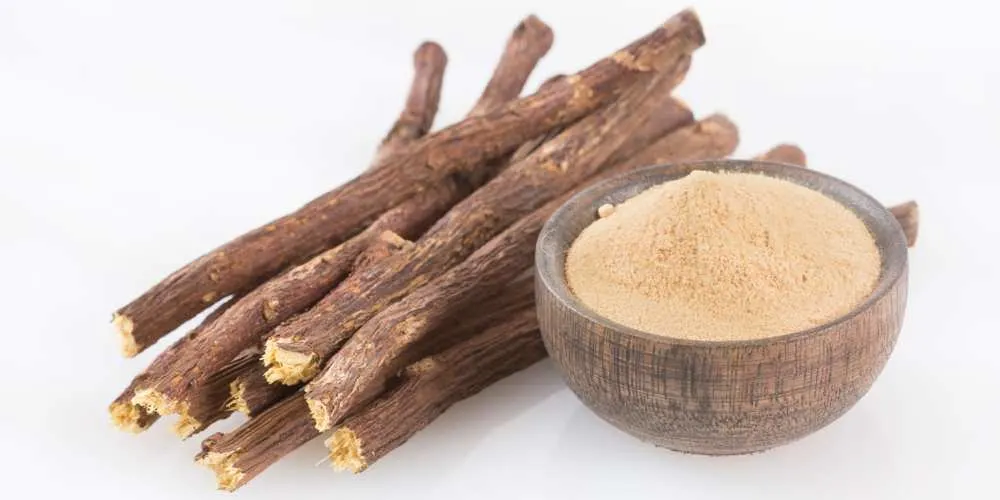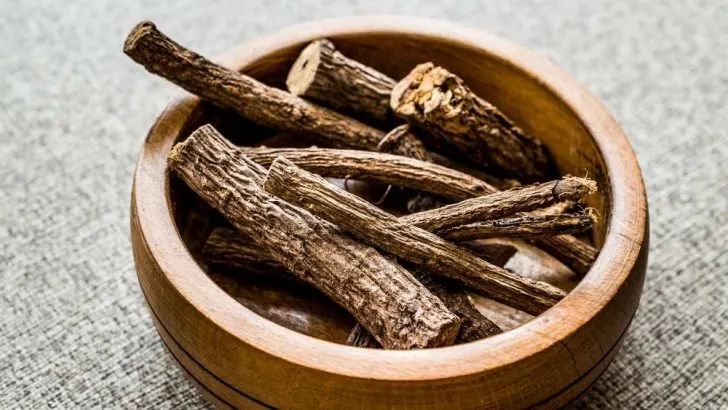Licorice is a food item that can be a plant or a sweet snack! It’s enjoyed by children and adults because licorice can be so tasty!
Candy is something that reminds almost all of us of our childhood. The herb, on the other hand, isn’t so well-known.
The tea made from the licorice plant can help soothe a cough and mild cold symptoms. All in all, it’s a useful plant – who knew!
Maybe this is the reason why you opted for this plant to grow in your garden or the balcony. What worries you, as it worries you usually, is whether the plant is safe for your dog.
Your dog managed to chew on every plant in the house and the garden, so you want to know should you keep licorice out of the dog’s reach or it’s fine. So, can dogs eat licorice?
Will something happen to your pet if she eats your licorice plant? Continue reading to find out!

Can Dogs Eat Licorice?
When we’re talking about licorice, it’s important to note which licorice we are talking about. We could be talking about the licorice plant, its roots, and leaves, or we could be talking about the candy called licorice. Licorice candy is made with the root extract of licorice, along with several other ingredients.
First, let’s talk about plant licorice. It’s perfectly safe and even good for humans, but what about dogs? Dogs can eat the licorice plant!
Be it the root or the leaves, the dogs can eat the licorice plant, as it’s completely safe. Be vary about the amount and the way you’re serving it, though. We’ll cover all that in our article.
First, before anything else, you should introduce the licorice plant into the dog’s diet. Dogs can have hypersensitivity and food allergies just like humans.
So, whenever you give your pet something new, watch her reaction afterward. If she responds well, she should be as playful as she always is. If you see lethargic and suspicious behavior in your dog, discontinue the use immediately!
What About Black Licorice?
The black licorice candy is something pretty much anyone enjoys. We believe it’s because it’s a reminder of a simpler, carefree time.
Furthermore, can your dog be included in enjoying this sweet? Well, to be fair, feeding your dog black licorice is not the best idea. A little taste won’t harm your pup, but more on that later.
Black licorice is made from the root extract of licorice. The root extract has amounts of a compound called glycyrrhizin. Glycyrrhizin when eaten regularly by dogs can cause the blood pressure to elevate to dangerous levels.
Also, the black licorice has loads of sugar, which is something that your dog should avoid at all times. Dogs need to retain a sugar-free diet to avoid diabetes and obesity.
This doesn’t mean that you should give your pet sugar-free licorice. Sugar-free licorice contains xylitol, which is heavily toxic for dogs.
Just three grams of xylitol can kill a 60-pound dog! Whenever you want to give your pup a junk food snack, check the ingredients list for xylitol. If it even contains trace amounts, please refrain from giving your dog any licorice – it could be lethal!
Also, What About Red Licorice?
We have established that your pup can eat a little black licorice without any harm coming to them, but what about red licorice?
Red licorice isn’t lethal for your pup, but it’s something highly unhealthy for them. Your dog should stay away from red licorice because it’s a sugary snack.
Sugar is something your dog should never, ever eat. Loads of sugar will lead to diabetes, and diabetes will lead to obesity. Obese dogs aren’t as playful and their lifespan is significantly shorter due to the extra pounds.
But, if your dog just yearns for a taste, it’s fine. Red licorice should just be avoided regularly because of the long-term effects!

Introducing The Licorice Plant To Your Pet’s Diet
The introduction is a method used for adding new food items to your dog’s diet. This is a very good method for adding new food, and for a few reasons.
The number one reason is that dogs need time to adjust to something new. Whenever they do try something new, they can be put off by the mere appearance of that food.
Dogs tend to dislike food that looks nothing like meat, and let’s face it – the licorice plant doesn’t even resemble meat. This happens because dogs need a lot more meat than veggies in their diet, despite being omnivores.
The second reason why is checking how your dog responds to eating the licorice plant. Introducing a food item consists of giving the dog a tiny amount of the said food the first time, and increasing the dose every other time.
When dogs eat a tiny amount of the food they don’t respond well to, they are not likely to die or have any serious health complications. So, when you want to give your dog some licorice leaves, remember to start small.
Because of that, it might be best to add licorice leaves or roots to their regular, commercial dog food. Mix the leaves in, or sprinkle it on top, both work – remember to give them just a taste to see how they’re behaving!

Serving Licorice For Your Dog
When you’re serving licorice for your dog, there are a few things to remember. First of all, licorice has certain health benefits, and that’s usually the main reason why people like to give their dog some licorice.
If you opt for the licorice leaves, remember to wash the leaves first. Use a knife to chop them up into small bits. The leaves are sweet and tasty, which can get your dog excited.
And when dogs get excited, they forget to chew. The leaves can get stuck in their mouth or their throat, which can lead to some choking, spitting, and even vomiting.
All in all, just chop the leaves. Diced leaves can be mixed in with a commercial dog meal for the best results.
About the dosage: one or two small leaves are fine for a smaller or toy-sized dog breed. For larger pups, they can certainly eat about five leaves of the licorice plant.
When it comes to the licorice root, you can soak it in olive oil for a month to make a tincture. The tincture can be added for health benefits, but make sure you don’t go overboard.
Just a few drops of the tincture are enough for dogs under 30 pounds. If your dog weighs between 30 and 60 pounds, a ¼ of a tablespoon. If your dog is a large breed, ½ a tablespoon is fine.
Remember to abide by these recommendations. If your dog eats way too much licorice, consult a vet as soon as possible. It could be very dangerous for your dog!
Moreover, keep in mind that dogs do not need to eat licorice regularly to truly feel the benefits. Once every two weeks or once a month is usually enough!

Benefits Of Dogs Eating Licorice
There are various reasons why your dog’s diet could benefit from some licorice. Without any further ado, let’s talk about those reasons!
- Eating licorice can lessen joint pain in dogs who have arthritis. It could also reduce symptoms of gastrointestinal inflammation and help heal ulcers;
- Licorice is very good for liver health – licorice promotes the production of interferon, which is crucial for liver health;
- Licorice aids digestion because it has a decent amount of fiber – and fiber is a must-have for a good metabolism
- Eating licorice supports the immune system;
- Protects from cancer – licorice is an antioxidant, so it protects the skin from dangerous free radicals.

Dangers Related To Dogs Eating Licorice
Dogs eating licorice can be associated with certain risks. We said how important it is that dogs don’t eat too much.
If that happens, your dog might experience some diarrhea or vomiting. Don’t be alarmed yet, only if the problems persist for longer than three days – then it’s time to visit the doctor.
However, if your dog eats a lot of black or red licorice, visit the vet immediately. It could be a hazard to your pet’s life!

Bottom Line
To conclude, dogs can eat licorice. Just not licorice the way you think!
The licorice plant is very healthy and tasty for your pup. The health benefits alone are a good reason why you should introduce it to your furry baby’s diet!
However, the snacks called black and red licorice are not such a great idea. If the dog wants just a taste, it’s safe – but no more than that!
Learn More: What Can Dogs Eat? A Comprehensive List Of Dog-safe Foods

